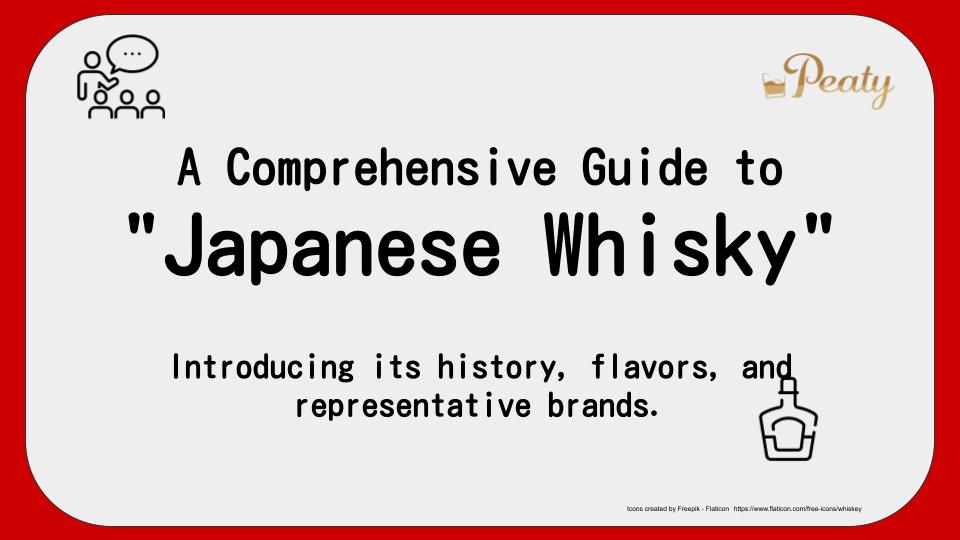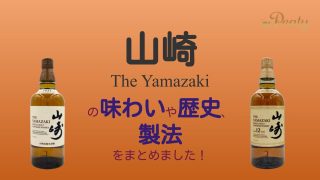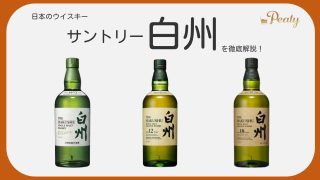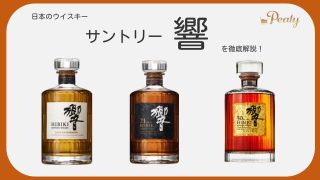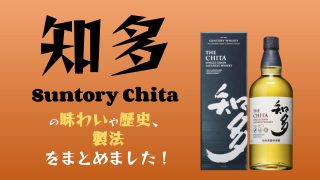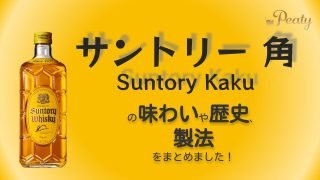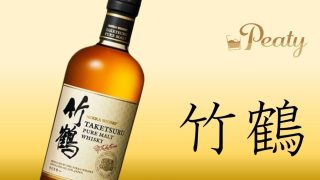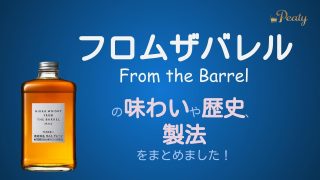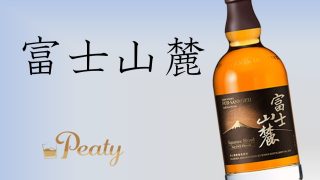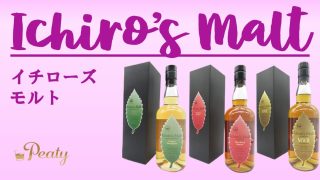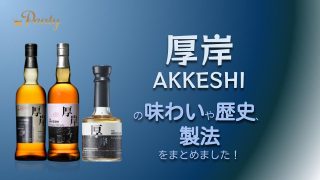What is Japanese Whisky?
The term “Japanese Whisky” refers to whisky produced in Japan. In recent years, it has gained popularity, and even those who are not particularly interested in whisky may have heard the term.
In fact, Japan is one of the world’s leading whisky-producing nations. By the 2010s, Japan ranked fourth in the global whisky consumption rankings, showing just how much whisky is enjoyed in the country.
The top two countries in global whisky consumption are India and the United States, both of which have large populations. Considering consumption per capita, it becomes clear just how much whisky is consumed in Japan.
Furthermore, many whiskies produced in Japan are highly regarded worldwide for their quality. Numerous Japanese whiskies have won international awards.
In this article, we will introduce you to the world of “Japanese Whisky.”
What is the Definition of Japanese Whisky?
There are two types of definitions: one under the Liquor Tax Law and the other defined by the Japan Spirits & Liqueurs Makers Association.
The Definition of Japanese Whisky under the Liquor Tax Law
Under Japanese liquor tax law, Japanese whisky is defined as follows.
It is a distilled beverage made from malted grains and water, or an alcoholic substance produced by saccharifying grains with malted grains and water, with an alcohol content below 95% at the time of distillation. Additionally, legally specified items, including alcohol, may be added.
Due to the lack of regulations such as a minimum aging period, Japan’s whisky laws are considered relatively lenient compared to those in other countries.
This leniency also applies to labeling, as there are no legal restrictions on indicating the place of origin on whisky labels.
Because the Liquor Tax Law’s definition of Japanese whisky is relaxed, there are cases where substandard whisky is sold under the name “Japanese Whisky.” This is especially concerning as Japanese whisky has recently gained popularity worldwide, leading to an increase in whiskies marketed as Japanese Whisky.
If this trend continues, there is a risk that “Japanese Whisky” will become associated with inferior products, which could harm the hard-earned reputation of the brand.
The Definition of Japanese Whisky Established by the Japan Spirits & Liqueurs Makers Association
To protect the Japanese whisky brand, the Japan Spirits & Liqueurs Makers Association established voluntary standards in 2021, which are followed by 82 companies licensed to produce whisky domestically.
This is known as the “Standards for Labeling Japanese Whisky,” and it represents the latest definition of “Japanese Whisky.”
- The raw ingredients are limited to malt, grains, and water sourced from within Japan, with malt being a required ingredient.
- Mashing, fermentation, and distillation must be carried out at a distillery in Japan, with the alcohol content at the time of distillation not exceeding 95%.
- For storage, the whisky must be aged in wooden casks with a capacity of 700 liters or less, and it must be stored within Japan for at least three years from the day following the casking date.
- Bottling must take place in Japan, with the alcohol content at the time of filling at 40% or higher.
Additionally, when it comes to labeling “Japanese Whisky,” it is prohibited to separate the words “Japanese” and “Whisky” with spaces or symbols. So, if you see labels like “Japanese Single Malt Whisky” or “Japanese Craft Whisky,” you might want to be cautious (haha).
On the other hand, the use of caramel for slight color adjustments is permitted. Although maturation is required to occur in wooden casks, there is no specification on the type of wood.
If these conditions are not met, the product cannot be labeled as “Japanese Whisky.”
As a result, it is no longer possible to sell whisky imported from other countries as “Japanese Whisky” just by casking it in Japan. The requirement to “always use malt” also prevents other beverages like awamori or shochu from being marketed as “Japanese Whisky.”
What Happens If the Definition of “Japanese Whisky” Is Not Met?
Alcohol that does not meet the “Standards for Labeling Japanese Whisky” cannot bear the following terms. This means that such wording cannot be included in the name.
- Personal names that remind one of Japan.
- Place names such as city names, regional names, famous landmarks, mountain names, and river names within Japan.
- The national flag of Japan and the era name (gengō).
- Any other representations that may mislead people into thinking they meet the standards.
However, this standard only applies when labeling a product as “Japanese Whisky.” Therefore, there is a loophole in that it does not need to be followed if one does not claim to be “Japanese Whisky.”
The challenge lies in how to raise awareness of this standard among both domestic and international businesses and ensure compliance.
The History of Japanese Whisky
The Arrival of Whisky in Japan
As for when whisky, originally from overseas, was first brought to Japan, records suggest it was on June 23, 1853.
Some of you might recognize this date.
Yes, it was Admiral Perry and his Black Ships that introduced whisky to Japan.
Before the Black Ships arrived in Honshu, they made a stop in Okinawa (then known as the Ryukyu Kingdom), where a banquet was held, and whisky was reportedly served.
Afterward, Admiral Perry and his crew landed on Honshu, and there are records indicating that they presented whisky to Tokugawa Iesada, the 13th shogun of the Tokugawa shogunate. However, it is unclear whether the shogun actually tasted it.
This period marked the establishment of foreign settlement areas, leading to an increase in foreign residents.
These foreigners naturally enjoyed whisky, which led to the establishment of companies like the Baker Company in 1861, the first liquor import company in Yokohama, and the Tasam Company, which also dealt in alcoholic beverages. Consequently, whisky began to be imported into Japan.
However, whether the whisky actually reached the Japanese people is another matter.
There are stories that whisky was served at the bar of the Yokohama Hotel, which was Japan’s first Western-style hotel, but it was certainly not a place accessible to the common people.
The first whisky imported specifically for the Japanese market is said to be “Cat Brand Whisky,” which was handled by the Carnot Company in 1871.
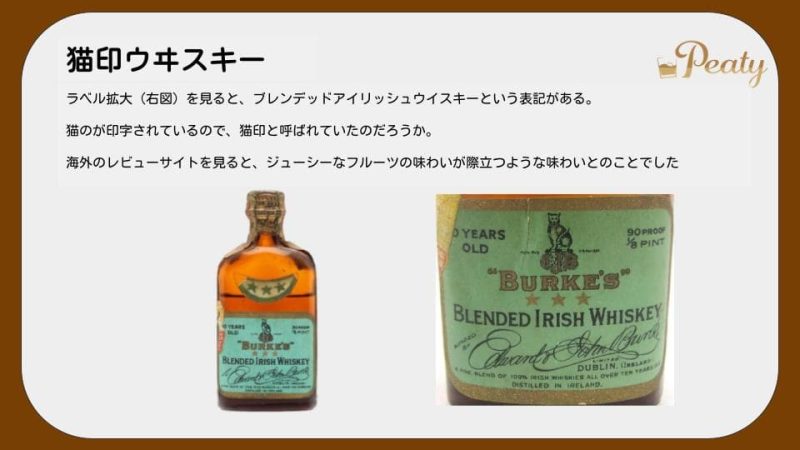
The Carnot Company appears to have been engaged in the import of alcoholic beverages in Yokohama from the 1860s to the 1900s.
It wasn’t until much later that Japan established its first whisky distillery, which was the Yamazaki Distillery built by Suntory in Kyoto in 1923.
The Rise of Japanese Whisky by Shinjiro Torii and Masataka Taketsuru
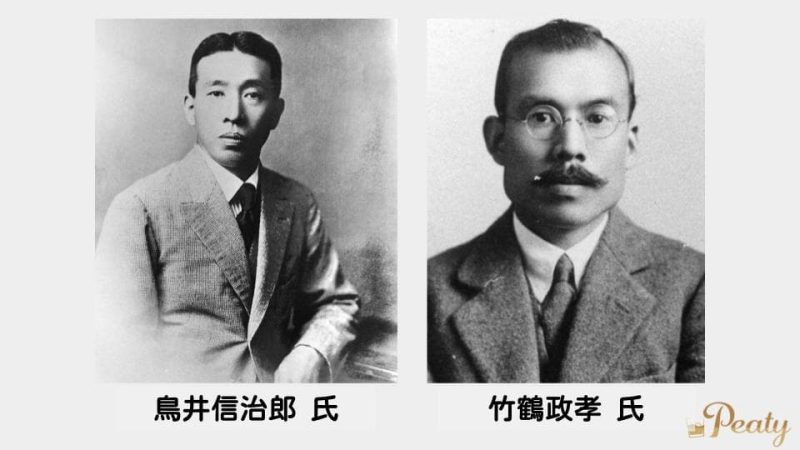
Shinjiro Torii and Masataka Taketsuru.
These two individuals are indispensable when discussing the development of Japanese whisky.
Even those unfamiliar with whisky may have heard their names.
As mentioned earlier, the Yamazaki Distillery could not have come into existence without the contributions of these two.
Before Shinjiro Torii Started Making Whisky
First, let’s introduce Shinjiro Torii.
Known as the founder of Suntory, Shinjiro Torii apprenticed at a drugstore dealing in wine and whisky from the age of 13. During this time, he gained knowledge about Western liquor and, after becoming independent, engaged in the blending and importation of whisky and wine.
At that time, foreign wines did not suit the Japanese palate, so he developed a wine that would appeal to Japanese tastes, using Portuguese wine as a reference.
This became known as “Akadama Port Wine.”
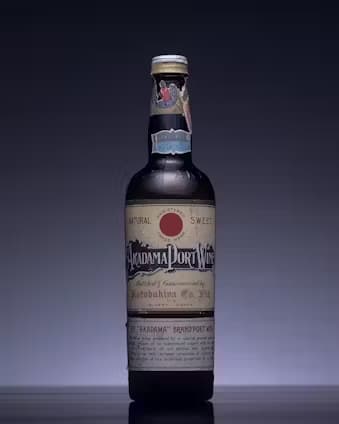
Shinjiro Torii Aimed for the Production of Domestic Whisky
Shinjiro Torii, not content with the success of Akadama Port Wine, dedicated his life to a significant endeavor: the creation of domestic whisky.
Aiming not just to produce imitation whisky but to make genuine whisky in Japan, Torii contemplated building a distillery.
However, due to environmental differences with whisky-producing regions like Ireland and Scotland, as well as the enormous costs associated with construction, there were many voices of opposition.
Nevertheless, Torii did not give up. He sought to invite engineers from Scotland for the construction and initiated communication with local contacts.
During this correspondence, he learned that Masataka Taketsuru, who had been studying whisky production in Glasgow, had returned to Japan, leading to his invitation to Torii’s company, Kotobukiya.
The Father of Japanese Whisky, Masataka Taketsuru
On the other hand, what kind of life did Masataka Taketsuru lead?
Born as the son of a sake brewer, Taketsuru had an interest in Western liquor, which led him to join Settsu Shuzo.
When Settsu Shuzo embarked on the production of pure domestic whisky, he was dispatched to Scotland to learn whisky-making at its source.
He gained experience not only through classroom lectures at the University of Glasgow but also through practical training at two distilleries: Longmorn and Hazelburn, before returning to Japan.
However, the techniques that Taketsuru brought back were not utilized at Settsu Shuzo.
Due to the recession following World War I, they were unable to secure funding, and the production of pure domestic whisky came to a halt.
After that, Taketsuru left Settsu Shuzo and began teaching chemistry at a high school.
It was during this time that he was invited by Shinjiro Torii to join Kotobukiya.
The Construction of the Yamazaki Distillery and Beyond
In this way, the key figures Torii and Taketsuru came together at Kotobukiya.
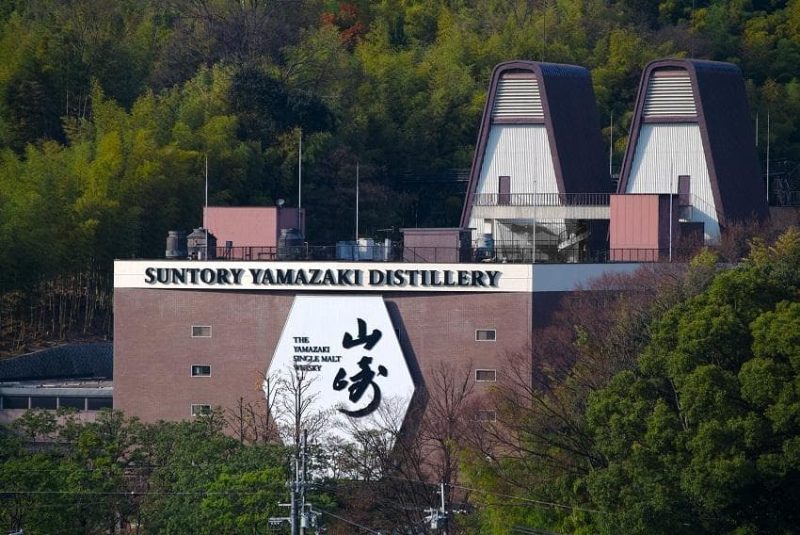
Despite various disagreements between the two, after extensive discussions and investigations, the Yamazaki Distillery was built in Ōyamazaki, Kyoto Prefecture.
As you may know, this led to the creation of numerous Japanese whiskies.
The first whisky produced using domestically grown barley and Scottish peat was the “Hakushu” (now known as Suntory White). Following that, they developed various whiskies such as “Kaku Bottle” (now Suntory Kaku) and “Suntory Whisky Black Label” (now Suntory Old).
Later, Tokyo Breweries entered the whisky market, and Taketsuru established Nikka Whisky and built the Yoichi Distillery, further invigorating Japanese whisky production.
However, the shadow of war loomed ominously over this progress.
Kotobukiya lost its factory in Osaka due to war damage, but the Yamazaki Distillery narrowly escaped the ravages of war.
Post-War Rise of Japanese Whisky
Right after the war, it became difficult for civilians in Japan to even have the opportunity to taste or obtain whisky.
In response, Torii began promoting his company’s whisky to the officers of the GHQ, gaining popularity as a result.
In 1946, he used the malt whisky that had survived the war from the Yamazaki Distillery to launch “Toris Whisky.”
By 1950, “Old” was once again available for sale. It was also around this time that the “Suntory Kaku Bottle” was released.
Kotobukiya changed its name to Suntory, and more companies began entering the whisky market, including Daikoku Wine and Honbo Shuzo. In the 1960s, Asahi (now Asahi Shuzo) began serious production of grain whisky.
As a result, the number of whisky manufacturers increased, and the market began to mature.
Whisky during Japan’s High Economic Growth Period
As Japan recovered from the chaos of the post-war years, whisky gradually became a part of people’s lives, particularly thriving during the high economic growth period.
During this time, the phrase “If you succeed, drink Kaku” became popular. It was an era where people started with Toris whisky, and once they achieved a certain level of success, they would switch to Kaku, while those who experienced great success would enjoy Old.
By the 1980s, Suntory Old surpassed annual shipments of 12,000,000 cases, setting world records.
However, around this time, the market began to show signs of stagnation.
Recent Globalization of Japanese Whisky and the Craft Distillery Boom
In order to avoid stagnation, various sake companies began to take action, giving rise to what are now known as “local whiskies.” It was also during this period that well-loved whiskies such as Yamazaki and Hibiki were created.
With changes in the liquor tax law, whiskies became more affordable for the general public, leading to a surge in popularity.
As mentioned in the definition section, Japanese liquor tax laws have more lenient standards for whisky compared to those in other countries.
As various companies began to enter the market, some poor-quality whiskies also emerged. The scrutiny from overseas regarding low-quality whiskies was severe, and it is said that the reputation of Japanese whisky suffered as a result.
However, gradually, the perception began to change for the better. By the 2000s, many whiskies started receiving high praise, and now, their popularity abroad has become firmly established.
Suntory’s Commercial That Sparked the Highball Boom
Around the 2000s, as Japanese whisky’s popularity at home continued to decline, Suntory began to take steps to introduce whisky to a younger generation.

Whisky was often seen as a drink for middle-aged or older people, so Suntory’s strategy to make it more approachable for younger people was to popularize highballs.
Originally served at around 12% ABV, the highball recipe was modified for ease of drinking and reduced to about 7% ABV.
The commercial for ‘Kaku Highball’ played a key role in sparking its popularity. Personally, the catchy CM song made me curious about whisky.
Some of you might have had similar experiences or feel a sudden craving for highballs or whisky whenever that song plays.
The morning drama effect led to an unprecedented rise in whisky’s popularity in Japan.
A few years later, in 2014, the morning drama ‘Massan,’ inspired by the lives of Masataka Taketsuru and his wife, Rita, captivated audiences, driving whisky’s popularity to new heights.

Around the same period, the popularity of Japanese whisky continued domestically, largely due to the growing number of international awards received by both large and small distilleries in Japan.
Recently, small-scale craft distilleries have also become a major trend.
Many companies that originally specialized in producing sake and shochu have entered the market on a small scale, allowing them to focus on unique and highly personalized methods.
From maturation environments and raw ingredients to bottle selection, each distillery’s attention to detail makes exploring and finding personal favorites a delight.
Due to their smaller size, production volumes are limited, and some products even fetch high prices at auctions.
Characteristics of Japanese Whisky
Japanese whisky has two major defining characteristics:
It is easy to drink and maintains consistently high quality.
The Drinkability of Japanese Whisky
First and foremost is its drinkability.
In Japan, it’s common to enjoy alcohol with meals or alongside food, so beverages that complement rather than overpower the flavors of food are preferred.
This balance extends to both taste and aroma.
If you think of traditional Japanese drinks like sake and shochu, this concept becomes clear.
The highball, a popular way to enjoy whisky in Japan, is actually unique to the country and pairs well with strong-flavored dishes like fried foods.
The Consistent Quality of Japanese Whisky
Another important aspect is the consistent quality resulting from production by major distilleries.
While there are now many craft distilleries, the majority of Japanese whisky is still produced by large companies like Suntory and Nikka Whisky.
As a result, they maintain a stable quality, ensuring a consistent flavor profile.
Although Scotland has a higher number of distilleries compared to Japan, many of them are small-scale. Smaller distilleries often face challenges in producing whisky with stable quality year after year.
Due to its consistent quality, Japanese whisky receives high praise from international markets and frequently wins global whisky awards.
In 2001, the “Single Cask Yoichi 10-Year-Old” received the highest score at the World Whisky Awards.
In 2015, the “Yamazaki Single Malt Sherry Cask 2013” was rated the best in the world by the Whisky Bible 2015.
In 2017, the “Hibiki 21-Year-Old” won the top prize in the World Whisky category at the International Spirits Challenge (ISC).
Additionally, Ichiro’s Malt from the Chichibu Distillery has also won numerous whisky awards.
Representative Brands and Distilleries of Japanese Whisky
Representative Brands and Distillery Produced by Suntory
Yamazaki

This is whisky produced at the Yamazaki Distillery, Japan’s first distillery, which needs no introduction.
It embodies the dreams of Shinjiro Torii and Masataka Taketsuru, which we’ve already discussed.
The Yamazaki Distillery is located in Yamazaki, Hommachi, Mishima-gun, Osaka Prefecture (which is actually not in Kyoto) and is situated near the Minase Shrine, known for its high-quality water that has been selected as one of Japan’s Top 100 Famous Waters. This pure water is used in the whisky-making process.
Representative brands include “Yamazaki Non-Age” and “Yamazaki 12-Year-Old.”
Yamazaki Non-Age is the regular bottle of Yamazaki, crafted by blending various malt whiskies, including the distillery’s traditional Mizunara oak cask-matured spirits.
This expression features a distinctive profile with fruity notes reminiscent of strawberries and the elegance of dry mango and vanilla. The recommended way to enjoy it is on the rocks.
Yamazaki 12-Year-Old, on the other hand, is created by vatting spirits matured in wine casks, Mizunara oak casks, and sherry casks, resulting in a deep flavor reminiscent of the diverse spirits available at the Yamazaki Distillery.
This whisky encapsulates the essence of Yamazaki, making it the perfect choice for those looking to experience the true character of Yamazaki. You can truly appreciate the skill and dedication of the blender.
Hakushu

The Hakushu Distillery, where Hakushu whisky is produced, is a Suntory distillery located in Hokuto City, Yamanashi Prefecture.
Nestled at the foot of the Southern Alps and surrounded by nature, it is often referred to as the “Forest Distillery,” a name that some may recognize from commercials and other media.
The Hakushu Distillery was built to commemorate the 50th anniversary of Suntory Whisky.
It was established with the aim of creating whisky with a different personality from the Yamazaki Distillery, and the location was chosen after extensive searches for pure water suitable for whisky production.
Hakushu has gained immense popularity worldwide, winning various international whisky awards annually from the late 2000s to the 2010s.
Due to its high demand, it has become increasingly rare to find in Japanese liquor stores lately.
The standard offering from Hakushu is “Hakushu (Non-Age).”
This whisky is characterized by its refreshing quality while also possessing a hint of smokiness.
It is well-suited for drinking as a highball, and the variation known as “Forest Fragrant Highball,” which includes additional mint, has also gained popularity.
Due to its crispness, it can be enjoyed easily as a food pairing.
On the other hand, “Hakushu 12-Year-Old” has a longer aging period, with all of its component whiskies aged for at least 12 years.
While it retains the refreshing character of the non-age version, it also includes a soft sweetness.
This whisky is best enjoyed straight rather than as a highball, allowing you to slowly savor the unique flavors of Hakushu without distractions from food.
Hibiki

Hibiki is a blended whisky crafted by expertly blending malt whiskies produced at three distilleries owned by Suntory: Yamazaki, Hakushu, and Chita.
The blender skillfully identifies the unique characteristics of each whisky and adjusts the blend according to the time and conditions, so the exact ratios remain a mystery.
This enigmatic aspect adds to its allure.
The standard offering from Hibiki is “Hibiki Japanese Harmony.”
Crafted under the concept of harmonizing Japan’s four seasons, the delicate sensibility of the Japanese people, and the craftsmanship of Japanese artisans, this whisky features a floral aroma reminiscent of roses, honey-like sweetness, and a gentle finish.
It can be enjoyed straight, and adding water allows for a delightful change in flavor while maintaining a solid sweetness, making it an easy-to-drink whisky.
Its exquisite harmony and flavor make it a must-have addition to any whisky lineup, appealing to both novices and connoisseurs alike.
While it may be difficult to find in your home collection, “Hibiki Blender’s Choice” is relatively easy to encounter in bars.
This whisky is not intended for general consumers but is sold to restaurants.
Not only is it blended with a rich variety of whiskies, but it also uses whisky that has been aged in wine casks, imparting a floral aroma, soft sweetness, and fruity acidity.
If you come across it while dining out, be sure to give it a try.
Chita

The Chita Distillery, located in Chita City, Aichi Prefecture, is Suntory’s third distillery.
Chita is a grain whisky that was originally produced not for sale as a standalone product but to be used as a base for blended whisky.
When it was released as a regional exclusive in Aichi Prefecture, its exceptional flavor quickly gained popularity, leading to its launch as a separate item called “Chita.”
Its quality is well recognized, having won gold medals twice at the International Spirits Challenge (ISC).
Using corn as the main ingredient and employing a continuous still, the Chita Distillery utilizes its four columns to produce three types of grain whisky.
The standard offering is “Chita (Non-Age).”
It is Suntory’s first single grain whisky, characterized by fruity aromas reminiscent of pear and green apple, along with deep sweetness from vanilla and bitter chocolate, leaving a subtle woodiness in the finish.
It is recommended to enjoy it as a highball, which can be easily customized by adding ingredients like sudachi lime or Japanese pepper.
With its light mouthfeel and lack of strong flavors, this whisky is an excellent choice even for beginners.
Differences Between Yamazaki, Hakushu, Hibiki, and Chita
The differences among the four famous Japanese whiskies (Yamazaki, Hakushu, Hibiki, and Chita) lie in their production methods.
- Yamazaki and Hakushu are single malts produced at different distilleries.
- Chita is a grain whisky.
- Hibiki is a blended whisky that combines Yamazaki, Hakushu, and Chita.
Whisky comes in three types: malt whisky, grain whisky, and blended whisky.
Malt whisky is made from malt produced at a single distillery. In particular, a bottle containing malt whisky made exclusively at one distillery is called a single malt.
Grain whisky is made from grains.
Blended whisky is a mixture of malt whisky and grain whisky.
Based on the above definitions, Yamazaki and Hakushu can be classified as single malt whiskies produced at the Yamazaki Distillery (Osaka Prefecture) and the Hakushu Distillery (Yamanashi Prefecture), respectively.
Chita is a grain whisky produced at the Chita Distillery (Aichi Prefecture).
Hibiki is a blended whisky that combines the three aforementioned brands.
Kaku

Even in the realm of Japanese whisky, which is often said to be in short supply, Kaku is so widely available that there isn’t a day when we don’t see it.
As the hot season approaches, I can’t help but reach for a bottle of Kaku and crave a highball.
It’s also popular as “Kaku Highball,” isn’t it?
Kaku is a blended whisky made by combining the base spirits from the Yamazaki and Hakushu distilleries.
Its smooth and light profile makes it an ideal choice for whisky beginners looking to try their first bottle.
In the past, several varieties were available, but currently, the only one officially sold is this Kaku bottle.
Upon tasting, a sweet flavor unfolds, followed by a rich and deep complexity.
Whether enjoyed on its own or paired with food, it’s a delicious whisky experience.
Representative Brands and Distilleries Produced by Nikka Whisky
Yoichi

Yoichi is a whisky produced at the Yoichi Distillery located in Yoichi, Hokkaido.
The Yoichi Distillery is known as the place where Masataka Taketsuru, who left Suntory, built a distillery to create whisky with the same dedication as he did in Scotland, under similar environmental conditions.
The most notable feature of the distillery is its use of “coal direct-fire distillation,” which requires the skill of experienced craftsmen. This technique contributes to the unique roasted aroma and flavor characteristic of Yoichi.
With a meticulous approach to the aging environment, Yoichi has garnered high praise not only in Japan but also internationally, earning numerous awards over the years.
The standard offering is “Single Malt Yoichi.”
While it possesses the sweetness and fruitiness characteristic of sherry casks, it also clearly exhibits smokiness, peatiness, and a hint of saltiness. This makes it more suitable for seasoned whisky enthusiasts, particularly those who prefer Scotch whisky, rather than for beginners.
Ideally, one would want to savor the flavors of Yoichi neat, but enjoying it as a highball is also delightful.
A more expert-oriented offering, often compared to Islay malts rather than typical Scotch, is the “Single Malt Yoichi Peaty & Salty.” This particular whisky is available exclusively at the Yoichi Distillery.
Recently, it seems that it is also available for purchase online.
Because it uses a raw spirit with a stronger peat character, it clearly expresses the peatiness and saltiness, leading it to be compared to Islay malts.
The recommended way to enjoy it is, of course, neat.
If you want to experience the essence of Yoichi while also enjoying the characteristics of Islay malts, definitely give it a try.
Miyagikyo

Miyagikyo is a whiskey produced at the Miyagikyo Distillery of Nikka Whisky.
Located in Sendai City, Miyagi Prefecture, this distillery was established by Masataka Taketsuru, who had already set up the Yoichi Distillery in Hokkaido, to create a whiskey with a different flavor profile from Yoichi.
The distillery was built in a location that met three conditions: “south of Hokkaido,” “flat land,” and “availability of high-quality water.” This area also resembled the environment of Scotland, where Taketsuru learned about whiskey production.
The distillery is equipped with eight pot stills—four for the first distillation and four for the second. Additionally, a café-style still, which was moved from the Nishinomiya factory in Hyogo, is also installed, allowing for the production of grain whiskey.
The standard offering is Miyagikyo Non-Age.
It has aromas of oak, vanilla, and malt, and when sipped, the scent of Earl Grey tea spreads in the mouth.
You can enjoy it in various ways, including straight, on the rocks, or as a highball.
Nikka Coffey Malt, produced using the Coffey still mentioned earlier, differs from the currently dominant continuous stills. Although its distillation efficiency is lower, the Coffey still retains more of the raw material’s aromas and components.
Nikka Coffey Malt, which strongly features the sweetness and toastiness of malt along with the fragrance of the barrels, is best enjoyed straight.
You can feel the commitment of Masataka Taketsuru, who prioritized quality over efficiency, in this product.
Taketsuru

Taketsuru, which boasts high popularity both domestically and internationally, is a pure malt whisky created by vatting malt whiskies produced at the aforementioned Yoichi and Miyagikyo distilleries.
Strictly speaking, it is based on malt from the Miyagikyo distillery, with additional flavor derived from malt whisky matured in sherry casks at the Yoichi distillery.
Am I the only one who feels that this product encapsulates the commitment of Masataka Taketsuru?
Currently, the only standard product officially available for sale is the “Taketsuru Pure Malt (Non-Age).”
It features a refreshing fruitiness reminiscent of apples and a sweet aroma similar to vanilla.
The taste is fruity and light, with a subtle hint of peat in the background, making it a well-balanced whisky.
With its light mouthfeel and minimal off-flavors, it is considered easy for beginners to enjoy straight.
Among Japanese whiskies, it is relatively affordable and can be obtained directly from the official source, so be sure to give it a try!
While longer-aged products like Taketsuru 12-Year-Old were produced, they are now all discontinued from the lineup.
The Taketsuru 17-Year-Old, in addition to the typical characteristics of Taketsuru, features a sweetness reminiscent of vanilla and honey derived from sherry casks.
Though the price for purchasing it in stores or online can be quite daunting, it is sometimes spotted at bars, so enjoying a sip there can be a nice option.
It is also recommended to savor it on the rocks.
Black Nikka

Alongside Suntory’s Kakubin, Black Nikka is a representative whiskey that is often seen. Everyone must have seen the face of Lord Lowry at least once.
Black Nikka is created by blending malt whiskey from the Yoichi Distillery and grain whiskey from the Miyagikyo Distillery. The standard product, “Black Nikka Clear,” uses non-peated malt, resulting in a clean and crisp flavor, just as its name suggests.
The Black Nikka can be enjoyed as a refreshing highball, and what’s even more delightful is its price. You can typically find a bottle for around 1,000 yen, and since it’s delicious, it’s like a friend to the common folk.
This makes perfect sense. Black Nikka was created with the vision of Taketsuru Masataka to make Nikka Whisky a representative whiskey of Japan.
For it to be embraced by many people, it’s essential for the whiskey to be both accessible and easy to drink. Especially the standard product, “Black Nikka Clear,” embodies both of these qualities effectively.
From the Barrel

The blended whiskey we enjoy is the result of countless experiments by blenders in the lab, from which they select the ones they believe to be the best to bring to market.
From this desire to deliver the raw flavor directly from the barrel that the blenders taste in the lab, “From the Barrel” was created.
This product, filled with Nikka Whisky’s commitment, is made by vatting malt whiskey from the Yoichi Distillery with grain whiskey from the Miyagikyo Distillery.
Since it is made with almost no dilution, the flavor is robust. With an alcohol content of 51%, it was classified as “Special Class” upon its release in 1985.
While it didn’t gain much popularity in Japan at that time, it became popular in Europe and won the gold medal at the ISC for six consecutive years. This sparked a growing interest in Japan as well.
A notable feature of this whiskey is that it undergoes further maturation in barrels after blending, allowing the two types of whiskey to harmonize and create a deep flavor.
Currently, the only official product available is “From the Barrel.”
It retains the characteristic essence of Yoichi while providing a rich and smooth mouthfeel.
In addition to fruity aromas and baked goods, there is also a woodiness present.
Moreover, there are bitter notes reminiscent of coffee and chocolate, contributing to its layered taste.
Although it is relatively affordable, there have been whispers of it being discontinued.
If you’re interested, it’s a product you’d want to secure sooner rather than later.
Other Japanese Whiskies
Fujisanroku

Fujisanroku is a whiskey produced at the Kirin-owned Fujigotenba Distillery.
It is particularly characterized by its focus on grain whiskey production.
In addition to the commonly used multi-column continuous stills, it employs a unique kettle (batch distillation) system, allowing for the creation of light, medium, and heavy grain whiskeys.
In 2017, the master blender of Kirin Brewery, Kota Tanaka, won the World’s Best Master Distiller and Master Blender awards in the Icons of Whiskey competition.
Fujisanroku has received international acclaim for its numerous products, many of which have since been discontinued.
Currently, the only product officially available is “Fujisanroku Signature Blend.”
This whiskey is crafted from a selection of original spirits that have reached their peak maturation within the Fujisanroku range.
It features a complex aroma and flavor profile characterized by vibrant fruitiness, sweet pastry-like fragrances, and hints of peat.
With a complex and profound finish, it is recommended to be enjoyed straight for the best experience.
Ichiro’s Malt

The Ichiro’s Malt is produced at the Chichibu Distillery, established by Venture Whiskey Co. to save original spirits that were being made at the Tohashuzo’s Hanyu Distillery.
Ichiro Akuto, the heir to the former Tohashuzo, was originally interested in whiskey making and joined Suntory after graduating from university.
However, when his family business, Tohashuzo, applied for civil rehabilitation, he returned to Chichibu to help rebuild it.
Eventually, Tohashuzo was sold to Hinode Tsusho, which led to the decision to withdraw from the whiskey business.
Ichiro worked tirelessly to save 400 casks of whiskey at the Hanyu Distillery and found a place for their safekeeping.
He then began constructing the Chichibu Distillery.
What’s remarkable about Ichiro’s Malt is that they started selling whiskey using original spirits from the Hanyu Distillery era even before the distillery was established.
They turned the longer aging process and the stronger characteristics of the original spirits into a selling point.
This marked their first step as a venture.
It goes without saying that the subsequent popularity of Ichiro’s Malt is notable.
Having won numerous international awards, it became so popular that a set of 54 bottles sold at auction for over 100 million yen.
Among the popular and scarce Ichiro’s Malts, the “Ichiro’s Malt & Grain White Label” is said to be relatively easier to obtain.
It can also be acquired through the hometown tax donation system.
The whiskey starts with citrus aromas, followed by the richness of malt and oak, culminating in a refreshing finish.
You can enjoy it straight or on the rocks, but the highball, which accentuates the citrus aroma, is also highly recommended.
Additionally, the “Leaf Series” is also popular.
The “Double Distilleries” is a whiskey blended from original spirits of both the Hanyu Distillery and Chichibu Distillery, allowing drinkers to experience the flavors of different barrels from the past and present.
However, rumors of it being discontinued are circulating, making it a product worth acquiring now.
Akkeshi

Akkeshi is produced at the Akkeshi Distillery, which was established by Keiichi Hida, the president of Kanden Jitsugyo Co., with the desire to create whiskey in Japan similar to Islay malts.
Starting distillation in 2016 in Akkeshi, Hokkaido, which has a climate resembling Islay, they released their first item in 2018.
They are committed to using local ingredients and barrels, and while they currently use Scottish barley, they are also preparing to cultivate their own barley fields.
One of Akkeshi’s representative series is the “Twenty-Four Seasons Series.”
Released approximately every three months in line with Japan’s traditional calendar of twenty-four seasons, this series produces a variety of whiskeys, including malts and blends.
As a result, the flavor profiles vary across different releases, making it hard for enthusiasts to resist the urge to collect them all.
However, due to their limited production, they are quite hard to come by.
If you spot one at a bar, be sure to give it a try!
Summary
We have explored various aspects of Japanese whiskey, including its definition and product list.
Even though we refer to it as Japanese whiskey, we can see that there are many varieties produced in different regions of Japan.
In this article, we introduced major product lines, but there are many distilleries with unique characteristics, so be sure to find your own favorite!

